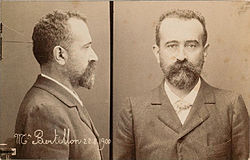This article needs additional citations for verification .(October 2014) |
| Criminology |
|---|
 |
| Main Theories |
| Methods |
| Subfields and other major theories |
| Browse |

Anthropological criminology (sometimes referred to as criminal anthropology, literally a combination of the study of the human species and the study of criminal behaviour) is a field of offender profiling, based on perceived links between the nature of a crime and the personality or physical appearance of the offender. [1] [2] [3]
Contents
- Mugshot and fingerprinting
- Theory
- Social Darwinism
- Modern times
- See also
- Notes
- References
- Bibliography
- External links
Although similar to physiognomy and phrenology, [4] the term "criminal anthropology" is generally reserved for the works of the Italian school of criminology of the late 19th century (Cesare Lombroso, Enrico Ferri, Raffaele Garofalo, and Lorenzo Tenchini). [2] [3] [4] Lombroso thought that criminals were born with detectable inferior physiological differences. [2] [3] [4] He popularized the notion of "born criminal" and thought that criminality was a case of atavism or hereditary predisposition. [1] [2] [3] His central idea was to locate crime completely within the individual and divorce it from surrounding social conditions and structures. A founder of the Positivist school of criminology, Lombroso opposed the social positivism developed by the Chicago school and environmental criminology.

